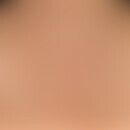Synonym(s)
HistoryThis section has been translated automatically.
Friedrich Hermann Rein, 1898-1953, physiologist in Göttingen
DefinitionThis section has been translated automatically.
The barrier between the granular layer(stratum granulosum) and the stratum corneum of the epidermis is called Rein's barrier. This barrier is not a rigid boundary but a dynamic area. It prevents the uninhibited evaporation of skin moisture and the penetration and absorption of harmful substances through the skin. Hence, the Rein's barrier represents an important physiological factor of the epidermal barrier structure.
The Rein'sche barrier mainly consists of horny layer lipids like ceramides and gamma linolenic acid. The special arrangement of these molecules contributes to an intact barrier function of the epidermis in the sense of a Helmholtz double layer (arrangement of the negative = acidic charges on the outside and the positive = alkaline charges on the inside of the horny layer). Thus, the barrier is positively charged towards the body surface and negatively charged towards the inside of the body. With pH 4.5 to 5.5 the lowest pH value of all skin layers is present here.
In dry skin the lipids of the horny layer are not in the right ratio and not in the right arrangement to each other. This makes the skin more permeable and sensitive to harmful substances. Clinically, this functional defect is manifested by increased scaling, desiccation eczema and intolerance reactions. It is also known that the function of the skin's barrier is also disturbed by inflammatory processes (Addor FA 2016).
LiteratureThis section has been translated automatically.
- Addor FA (2016) Skin barrier in pinkcea. To Bras Dermatol 91:59-63.
- Berkers T et al (22018) Degree of Skin Barrier Disruption Affects Lipid Organization in Regenerated Stratum Corneum. Acta Derm Venereol 98:421-427.
- Nielsen JB et al (2016) Penetration through the Skin Barrier. Curr Probl Dermatol 49:103-111



